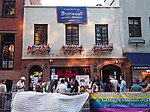Gay Liberation Monument

The Gay Liberation Monument is part of the Stonewall National Monument, which commemorates the Stonewall uprising of 1969. Created in 1980, the Gay Liberation sculpture by American artist George Segal was the first piece of public art dedicated to gay rights and solidarity for LGBT individuals, while simultaneously commemorating the ongoing struggles of the community. The monument was dedicated on June 23, 1992, as part of the dedication of the Stonewall National Monument as a whole.It is located directly across from the Stonewall Inn, at the northern end of Christopher Park, along Christopher Street in the West Village section of Manhattan, New York.The sculpture depicts two pairs of life-like, life-size, affectionate couples made of bronze and painted white. One couple (two men) are standing, and the other (two women) are seated. It was originally commissioned in 1979 (the 10th anniversary of the Stonewall uprising) by the Mildred Andrews Fund, a Cleveland-based foundation that supports public art displays. The commission specified that the work must be installed on public land and that it "had to be loving and caring, and show the affection that is the hallmark of gay people. ... And it had to have equal representation of men and women".
Excerpt from the Wikipedia article Gay Liberation Monument (License: CC BY-SA 3.0, Authors, Images).Gay Liberation Monument
Christopher Street, New York Manhattan
Geographical coordinates (GPS) Address External links Nearby Places Show on map
Geographical coordinates (GPS)
| Latitude | Longitude |
|---|---|
| N 40.73359 ° | E -74.00243 ° |
Address
Gay Liberation Monument
Christopher Street
10014 New York, Manhattan
New York, United States
Open on Google Maps






